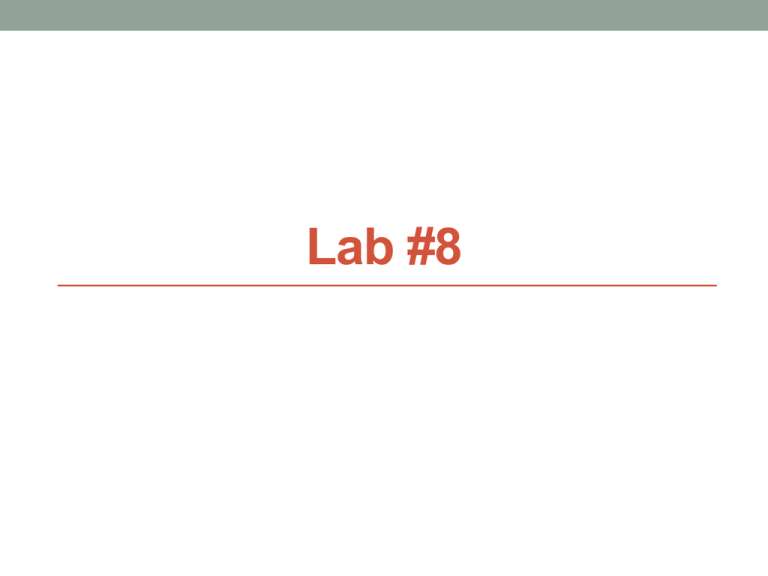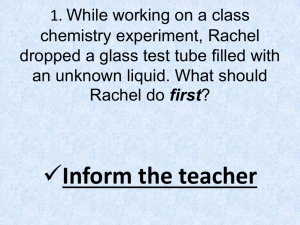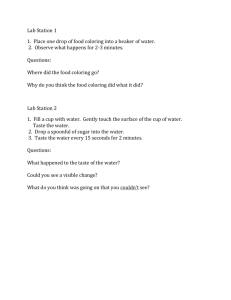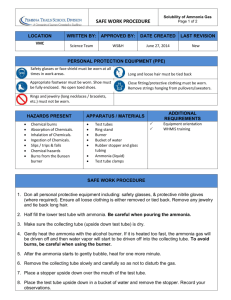RCC Lab 8 S14
advertisement

Lab #8 Review of Lab #7 - pH Indicators Memorize pH indicators and color reactions! pH Indicator Very acidic Acidic Neutral Basic Phenol red - pH <6.8 = yellow pH 6.9 - 8.0 = red pH >8.0 = magenta/ hot pink Litmus - pink purple blue Bromocresol Purple - yellow burgundy violet Methyl red pH <4.4 = red pH 5 - 6 = orange pH >6.3 = yellow - Review of Lab #7 • Positive sugar fermentation reaction: • A = acid production (yellow color change) • A/G = acid production (yellow) and gas in Durham tube • SA = slow reaction (orange color change) • Negative sugar fermentation reaction: • B = base production (pink/magenta color change) • (-) = No change Review of Lab #7 • Nitrate reduction test (pg. 81 – 83) • Media: Nitrate broth includes KNO3 • KNO3 ETC KNO2 + ATP • Detect KNO2 using reagents: • Sulfanilic acid (SA), and • Dimethyl-α-naphthlyamine (DAN) • Procedure • Take 1mL out from each culture & pour into a clean test tube • Add 3 drops of SA and 2 drops of DAN • Positive result: Red/ magenta color • Negative result: any other color Negative Positive Review of Lab #7 • Production of decarboxylase (pg. 87 – 90) • Enzyme decarboxylase removes carboxyl group from amino acids • Media: Lysine, ornithine, or arginine amino acid + sugar + bromocresol purple pH indicator + oil at top (anaerobic conditions) • Positive result: If the amino acid is decarboxylated CO2 is produced pH become basic purple • Negative result: • Sugar fermentation acid production yellow color change • No change • Cover oil with thumb and then observe results Positive Lab #7 Results • SIM Reactions (pg. 95 – 99) • SIM = Sulfide, Indole, and Motility (three tests in 1 tube!) • 1) Production of Hydrogen Sulfide • Some microorganisms can metabolize amino acid cysteine (in media) and produce H2S gas • H2S gas reacts with iron sulfate (in media) black precipitate positive result • 2) Production of Indole • Some microorganisms can metabolize amino acid tryptophan (in media) into indole (enzyme tryptophanase) • Indole is detected by adding 10 drops of Kovac’s reagent on top of the media red color change positive result Lab #7 Results • SIM Reactions (pg. 95 – 99) • SIM = Sulfide, Indole, and Motility (three tests in 1 tube!) • 3) Motility • Observe growth pattern • Growth away from stab line = motility Lab #7 Results • MR-VP Reactions (pg. 101 – 104) • Differentiate microorganisms on their fermentative end products • Sugar glucose is added to media • Each culture is split into two clean test tubes pour in 1mL of culture into each clean test tube • Methyl Red (MR) Test • Detects production of strong organic acids pH lowered to 4.4 or less • Add 10 drops of Methyl Red indicator • Positive result: red color strong acid is present • Negative result: yellow/ gold/ orange color Lab #7 Results • MR-VP Reactions (pg. 101 – 104) • Differentiate microorganisms on their fermentative end products • Sugar glucose is added to media • Each culture is split into two clean test tubes pour in 1mL of culture into each clean test tube • Voges Proskauer (VP) Test • Detects production of unusual alcohols acetyl methyl carbinol (AMC) • Add 10 drops of α-naphthol and 10 drops of KOH w/ creatine • Let sit for 20min (do not shake tube) • Positive result: a red ring on top • Negative result: any other color ring Today’s Lab – DEMO • Hydrolysis of Urea (pg. 91 – 93) • Some microorganisms produce enzyme urease breaks down urea into ammonia and CO2 • pH Indicator: Phenol red added to urea broth • Ammonia is a strong base media becomes basic • Positive result: Hot pink color • Negative result: yellow/ gold color indicates acidic conditions Today’s Lab – DEMO • Ammonium Phosphate Test (pg. 105 – 106) • This test uses a minimal media with only one source of nitrogen ammonia • Some microorganisms can metabolize ammonia and others cannot • Media: ammonium phosphate, glucose, potassium chloride, magnesium sulfate, and pH indicator bromocresol purple • Positive result: ammonia is metabolized media becomes acidic color change to yellow • Negative result: ammonia is not metabolized media remains basic color stays purple Today’s Lab – DEMO • Sodium Citrate Test (pg. 107 – 108) • This test uses a minimal media with only one source of carbon citrate • Some microorganisms can metabolize citrate and grow and others cannot • Positive result: growth in the media • Negative result: no growth Today’s Lab • Experiment #24 (pg. 115) • Mannitol Salt Agar (MSA) plate • Use a sterile cotton swab to obtain a throat or nose sample • Streak the first quadrant of an MSA plate using the cotton swab • Then use your sterilized loop to streak the remaining three quadrants streak for isolated colonies • Place plates in plastic container incubator Water Analysis Project and Lab Report • Pg. 131 – 138 • Test for presence of coliform (E. coli) G- rod bacteria found in the GI tract • Perform three tests (Pg. 136): • Presumptive • Confirmed • Completed • Procedure for presumptive test • Obtain 3 water samples A, B, and C • Inoculate 1mL of each into a separate Lactose broth tubes • Make sure tubes are properly labeled • Incubate the tubes • Read results in 24-48 hrs/ next lab Water Analysis Project and Lab Report • Presumptive test results (table on pg. 133) • Positive: Acid and gas production = “a/g” (color change to yellow and gas bubble in Durham tube) • Use positive tube to streak an EMB (Eosin Methylene Blue) plate Confirmed test • Confirmed test results • Positive: Metallic green colonies • Obtain a single colony from the positive streak plate and inoculate it into a lactose broth Completed test • Today: Completed test results • Positive: Acid and gas produced • Indicates the presence of coliform bacteria fecal contamination! • Record your results and class results






